The scruffy hare on the road…
The other day we saw a big hare calmly sitting in the middle of the road just above our house, and while we waited for him to get out of the way I thought vaguely of how I'd make a design out of him. This is the result. At first I was just going to call it “Hare on the Road” but perhaps “Scruffy Hare” would be more appropriate, as he turned out to have a rather moth-eaten appearance. This was because the hare seemed to be demanding to be appliqueed in some kind of furry, unkempt fabric, so I dragged out my embellisher and some old knitting yarn and spent some time making a nice furry fabric. The result wasn’t exactly slick, but then it wasn’t supposed to be so I went ahead and used it for the hare’s body.
The Hare on the Road with the moth-eaten coat
Well, yes, it sort of works, and I don’t mind the moth-eaten appearance, but next time I think I might do it differently. The eye isn’t quite right, and the overstitching on the body needs changing, but as I keep saying you never know how these things are going to turn out until you try them.
Another technical note: I stitched this out in rather a hurry, and when I looked at it after it was done I was horrified to see that I’d been in such a rush that I’d actually forgotten to put any stabiliser under it, so the embroidery is just done straight onto the unstabilised fabric. But the fabric was quite heavy, and the painted background also added a bit of weight and density, which is probably why I got away with it. All the same I’m going to have to be more careful in future!
